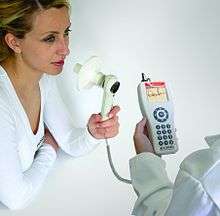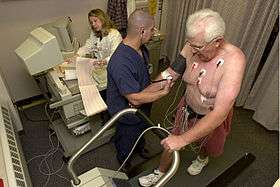Fitness to dive


Fitness to dive, (also medical fitness to dive), is the medical and physical suitability of a diver to function safely in the underwater environment using underwater diving equipment and procedures. Depending on the circumstances it may be established by a signed statement by the diver that he or she does not suffer from any of the listed disqualifying conditions and is able to manage the ordinary physical requirements of diving, to a detailed medical examination by a physician registered as a medical examiner of divers following a procedural checklist, and a legal document of fitness to dive issued by the medical examiner.
The most important medical is the one before starting diving, as the diver can be screened to prevent exposure when a dangerous condition exists. The other important medicals are after some significant illness, where medical intervention is needed there and has to be done by a doctor who is competent in diving medicine, and can not be done by prescriptive rules.[1]
General requirements
The medical, mental and physical fitness of professional divers is important for safety at work for the diver and the other members of the diving team.[2]
As a general principle, fitness to dive is dependent on the absence of conditions which would constitute an unacceptable risk for the diver, and for professional divers, to any member of the diving team. General physical fitness requirements are also often specified by a certifying agency, and are usually related to ability to swim and perform the activities that are associated with the relevant type of diving.
The general hazards of diving are much the same for recreational divers and professional divers, but the risks vary with the diving procedures used. These risks are reduced by appropriate skills and equipment.
Medical fitness to dive generally implies that the diver has no known medical conditions that limit the ability to do the job, jeopardise the safety of the diver or the team, that might get worse as an effect of diving, or predispose the diver to diving or occupational illness.[2]
There are three types of diver medical assessment: initial assessments, routine re-assessments and special re-assessments after injury or decompression illness.[2]
Fitness of recreational divers
Standards for fitness to dive are specified by the diver certification agency which will issue certification to the diver after training. Some agencies consider assessment of fitness to dive as largely the responsibility of the individual diver, others require a registered medical practitioner to make an examination based on specified criteria. These criteria are generally common to certification agencies, and are based on the criteria for professional divers, though the standards may be relaxed.
The purpose of establishing fitness to dive is to reduce risk of a range of diving related medical conditions associated with known or suspected pre-existing conditions, and is not generally an indication of the person's psychological suitability for diving and has no reference to their diving skills.
A certification of fitness to dive is generally for a specified period, (usually a year or less), and may specify limitations or restrictions.
In most cases, a statement or certificate of fitness to dive for recreational divers is only required during training courses. Ordinary recreational diving is at the diver's own risk.
In rare cases, state or national legislation may require recreational divers to be examined by registered medical examiners of divers.[3] In France, Norway, Portugal and Israel. recreational divers are required by regulation to be examined for medical fitness to dive.[4]
Standard forms for recreational diving
Recreational diver certification agencies may provide a standard document[5] which the diver is required to complete, specifying whether any of a range of conditions apply to the diver. If no disqualifying conditions are admitted, the diver is considered to be fit to dive. Occasionally divers have provided deliberately falsified medical forms, stating that they do not have conditions which would disqualify them from diving, sometimes with fatal consequences.
The RSTC medical statement is used by all RSTC member affiliates of the RSTC Canada, RSTC, RSTC-Europe and IAC (former Barakuda), FIAS, ANIS, SSI Europe, PADI Norway, PADI Sweden, PADI Asia Pacific, PADI Japan, PADI Canada, PADI Americas, PADI Worldwide, IDD Europe, YMCA, IDEA, PDIC, SSI International, BSAC Japan and NASDS Japan.[6]
Other certification agencies may rely on the competence of a general practitioner to assess fitness to dive, either with or without an agency specified checklist.
In some cases the certification agency may require a medical examination by a registered medical examiner of divers.
Fitness of professional divers
The requirements for medical examination and certification of fitness of professional divers is typically regulated by national or state legislation for occupational health and safety[7]
Fitness testing procedures


Lung function tests
A frequently used test for lung function for divers is spirometry, which measures the amount (volume) and/or speed (flow) of air that can be inhaled and exhaled. Spirometry is an important tool used for generating pneumotachographs, which are helpful in assessing conditions such as asthma, pulmonary fibrosis, cystic fibrosis, and COPD, all of which are contraindications for diving. Sometimes only peak expiratory flow (PEF) is measured, which uses a much simpler apparatus, but is still useful to give an indication of lung overpressure risk.
Cardiac stress test
The cardiac stress test is done with heart stimulation, either by exercise on a treadmill, or pedalling a stationary exercise bicycle ergometer, with the patient connected to an electrocardiogram (or ECG).
The Harvard Step Test is a type of cardiac stress test for detecting and/or diagnosing cardiovascular disease. It also is a good measurement of fitness, and the ability to recover after a strenuous exercise, and is sometimes used as an alternative for the cardiac stress test.
Medical examiner of divers
Disqualifying conditions
The general principles for disqualification are that diving causes a deterioration in the medical condition and the medical condition presents an increased risk for a diving injury to both the individual and the diving partner.[5]
There are some conditions that are considered absolute contraindications for diving. Details vary between recreational and professional diving and in different parts of the world. Those listed below are widely recognised.
Permanently disqualifying conditions
- If epilepsy is required to be controlled by medication, diving is contraindicated. (This includes childhood seizure disorders requiring medication). A possible acceptable risk would be a history of febrile seizures in infancy, apneic spells or seizures attendant to acute illness such as encephalitis and meningitis, all without recurrence without medication.[8]
- Stroke and transient ischemic attacks.[8]
- Intercranial aneurysm, arterial-venous malformation or tumor.[8]
- Exertional angina, postmyocardial infarction with left ventricular dysfunction, congestive heart failure, or dependence on medication to control dysrhythmias.[8]
- Postcoronary bypass surgery with violation of pleural spaces.[8]
- A history of spontaneous pneumothorax.[8]
Temporarily disqualifying conditions
Any illness requiring drug treatment may constitute a temporary disqualification if either the illness or the drug may compromise diving safety. Sedatives, tranquillisers, antidepressants, antihistamines, anti-diabetic drugs, steroids, anti-hypertensives, anti-epilepsy drugs, alcohol and hallucinatory drugs such as marijuana and LSD may increase risk to the diver. Some drugs which affect brain function have unpredictable effects on a diver exposed to high pressure in deep diving.[9]
Conditions which may disqulify or require restrictions depending on severity and management
Some medical conditions may temporarily or permanently disqualify a person from diving depending on severity and the specific requirements of the registration body. These conditions may also require the diver to restrict the scope of activities or take specific additional precautions. They are also referred to as relative contraindications, and may be acute or chronic.
Asthma
In the past scuba was generally considered a contraindication for diving due to theoretical concern about an increased risk for pulmonary barotrauma and decompression sickness. The conservative approach was to arbitrarily disqualify asthmatics from diving. This has not stopped asthmatics from diving, and experience in the field and data in the current literature do not support this dogmatic approach. Asthma has a similar prevalence in divers as in the general population.[10]
The theoretical concern for asthmatic divers is that pulmonary obstruction, air trapping and hyperinflation may increase risk for pulmonary barotrauma, and the diver may be exposed to environmental factors that increase the risk of bronchospasm and the development of an acute asthmatic attack which could lead to panic and drowning. As of 2016, there is no epidemiological evidence for an increased relative risk of pulmonary barotrauma, decompression sickness or death among divers with asthma. This evidence only accounts for asthmatics with mild disease and the actual risk for severe or uncontrolled asthmatics, may be higher.[10]
Diabetes
Like asthma, the traditional medical response to diabetes was to declare the person unfit to dive, but in a similar way, a significant number of divers with well-managed diabetes have logged sufficient dives to provide statistical evidence that it can be done at acceptable risk, and the recommendations of diving medical researchers and insurers has changed accordingly.[11][12]
Current (2016) medical opinion of Divers Alert Network (DAN) and the Diving Diseases Research Centre (DDRC) is that diabetics should not dive if they have any of the following complications:
- Significant retinopathy increases risk of retinal hemorrhage due to minor mask squeeze or equalizing procedures.[11][12]
- Peripheral vascular disease and/or neuropathy increase risk of sudden death due to coronary artery disease,[12]
- Significant autonomic or peripheral neuropathy increases the risk of exaggerated hypotension when leaving the water.[12]
- Nephropathy causing proteinuria[11][12]
- Coronary artery disease [11][12]
- Significant peripheral vascular disease may reduce inert gas washout and predispose the diver to limb decompression sickness.[11][12]
DAN makes the following recommendations for additional precautions by diabetic divers:
- Diabetic divers are advised not to dive deeper than 30 msw (100 fsw), to avoid situations where nitrogen narcosis could be confused with hypoglycemia, for longer than one hour, to limit the time blood glucose levels would remain unmonitored, or to incur compulsory decompression stops, or dive in overhead environments, both of which make direct and immediate access to the surface unavailable.[12]
- Diabetic diver's buddy or dive leader who is informed of their condition and knows the appropriate response in the event of a hypoglycemic episode. It is also recommended the buddy does not have diabetes.[11][12]
- Diabetic divers should avoid circumstances that increase risk of hypoglycemic episodes such as prolonged cold and strenuous dives.[12]
Pregnancy
A study investigating potential links between diving while pregnant and fetal abnormalities by evaluating field data showed that most women are complying with the diving industry recommendation and refraining from diving while pregnant. There were insufficient data to establish significant correlation between diving and fetal abnormalities, and differences in placental circulation between humans and other animals limit the applicability of animal research for pregnancy and diving studies.[13]
The literature indicates that diving during pregnancy does increase the risk to the fetus, but to an uncertain extent. As diving is an avoidable risk for most women, the prudent choice is to avoid diving while pregnant. However, if diving is done before pregnancy is recognised, there is generally no indication for concern.[14]
In addition to possible risk to the fetus, changes in a woman’s body during pregnancy might make diving more problematic. There may be problems fitting equipment and the associated hazards of ill fitting equipment. Swelling of the mucous membranes in the sinuses could make ear clearing difficult, and nausea may increase discomfort.[14]
Diving after childbirth
Divers who want to return to diving after having a child should generally follow the guidelines suggested for other sports and activities, as diving requires a similar level of conditioning and fitness.
After a vaginal delivery, without complications, three weeks is usually sufficient to allow the cervix to close, which reduces the risk of uterine infection. Divers Alert Network recommends as a rule of thumb, to wait four weeks after normal delivery before resuming diving, and at least eight weeks after cesarean delivery. Any complications may indicate a longer wait, and medical clearance is advised.[15]
See also
References
- ↑ Williams, G. Elliott, DH. Walker, R. Gorman, DF. Haller, V. Fitness to dive: Panel discussion with audience participation. SPUMS 2001 Volume 31 Number 3. Journal of the South Pacific Underwater Medicine Society http://archive.rubicon-foundation.org/7739 accessdate 2013-04-07
- 1 2 3 Jürg Wendling, David Elliott, Tor Nome (eds); European Diving Technical Council, (2003); Fitness to Dive Standards - Guidelines for Medical Assessment of Working Divers, http://www.edtc.org/EDTC-Fitnesstodivestandard-2003.pdf accessdate 2013-04-09
- ↑ Richardson, Drew. "The RSTC Medical statement and candidate screening model; discussion". South Pacific Underwater Medicine Society (SPUMS) Journal Volume 30 No.4 December 2000. South Pacific Underwater Medicine Society. pp. 210–213. Retrieved 26 January 2013.
- ↑ Elliott, D. (2000), "Why fitness? Who benefits from diver medical examinations?", Journal of the South Pacific Underwater Medicine Society., 30 (4), retrieved 2013-04-07
- 1 2 "Dive Standards & Medical Statement". World Recreational Scuba Training Council. Retrieved 26 January 2013.
- ↑ Richardson, Drew. "The RSTC Medical statement and candidate screening model". South Pacific Underwater Medicine Society (SPUMS) Journal Volume 30 No.4 December 2000. South Pacific Underwater Medicine Society. pp. 210–213. Retrieved 26 January 2013.
- ↑ "Diving Regulations 2009 of the South African Occupational Health and Safety Act, 1993", Government notice R41, Government Gazette, Pretoria: Government Printer (#32907), 29 January 2010
- 1 2 3 4 5 6 Vorosmarti J, Linaweaver PG (eds). Fitness to Dive. 34th Undersea and Hyperbaric Medical Society Workshop. UHMS Publication Number 70(WS-WD)5-1-87. Bethesda: Undersea and Hyperbaric Medical Society; 1987; 116 pages. http://archive.rubicon-foundation.org/4249 accessdate 2013-04-07
- ↑ Edmonds, Thomas, McKenzie and Pennefather (2010). Diving Medicine for Scuba Divers (3rd ed.). Carl Edmonds.
- 1 2 Adir, Yochai; Bove, Alfred A. (2016). Yochai Adir and Alfred A. Bove, eds. "Can asthmatic subjects dive?" (PDF). Number 1 in the Series “ Sports-related lung disease ”. European Respiratory Review. pp. 214–220. doi:10.1183/16000617.0006-2016. Retrieved 10 June 2016.
- 1 2 3 4 5 6 Staff (2016). "Diving and diabetes". Diver Health. Plymouth, UK.: Diving Diseases Research Centre - DDRC Healthcare. Retrieved 11 June 2016.
- 1 2 3 4 5 6 7 8 9 10 Pollock NW, Uguccioni DM, Dear GdeL, eds. (2005). "Guidelines to Diabetes & Recreational Diving" (PDF). Diabetes and recreational diving: guidelines for the future. Proceedings of the Undersea and Hyperbaric Medical Society/Divers Alert Network 2005 June 19 Workshop. Durham, NC: Divers Alert Network. Retrieved 11 June 2016.
- ↑ St Leger Dowse, M; Gunby, A; Moncad, R; Fife, C; Bryson, P (2006). "Scuba diving and pregnancy: Can we determine safe limits?". Journal of Obstetrics and Gynaecology. Taylor and Francis. pp. 509–513. doi:10.1080/01443610600797368. Retrieved 11 June 2016.
- 1 2 Held, Heather E; Pollock, Neal W. (2007). "The Risks of Pregnancy and Diving". DAN Medical articles. Durham, NC.: Divers Alert Network. Retrieved 11 June 2016.
- ↑ DAN medical team (June 2016). "Return to Diving After Giving Birth". DANSA website. Divers Alert Network. Retrieved 11 August 2016.
